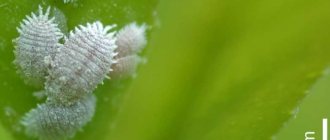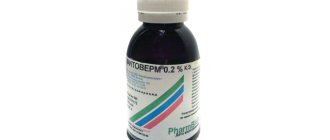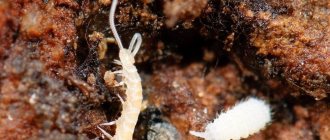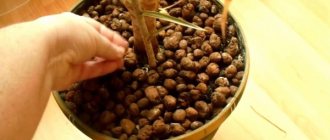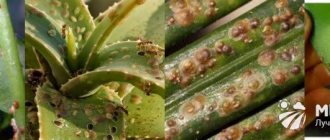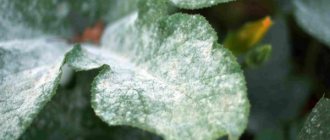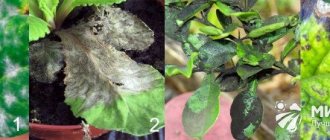Description of the pest
People also call it “furry lice” because of its appearance. They belong to the order of sucking insects . They are very difficult not to notice even with the naked eye. These suckers reach a length of up to 8 millimeters. The body of female scale insects is not fully developed and has an oval shape. But the males are already more similar to the insects we are familiar with: their body is not divided into sections, their limbs are well defined.
As adults, males do not feed because their mouthparts atrophy over time. But females and even larvae can easily make holes in leaves and buds, and then suck the juice out of them. This “function” of the mealybug poses the main danger to a healthy plant.
One of the difficulties in controlling hair lice is that they easily move from one plant to another . Details about what a mealybug is and how to deal with it are described in this article.
Aktara reviews
In general, Aktara is very popular among flower growers, gardeners and gardeners. Almost alone, it holds the palm among insecticides. Firstly, the drug does not have a pungent odor, like all others. Secondly, because the drug is systemic - it spreads from the juices throughout the plant and destroys the pest if you simply water it, i.e. Spraying is not necessary, although it is advisable. The fact is that mealybugs, and these include mealybugs, rootbugs and scale insects, are very tenacious (they are protected by a shield or a wax coating). And when sprayed, actara cannot always penetrate deeply into the lower layers of the epidermis.
Therefore, one spraying is not enough against this group of pests, especially on plants with dense, leathery leaves or fruits. Here, only simultaneous spraying and watering with actara is effective. In this case, the treatment must be repeated after 10-12 days.
Attention: Rosselkhoznadzor warns about fake aktar.
Toxicity
Aktara has a hazard class - 2 or 3 (hazardous substance, the class depends on the concentration), hazard class 1 for bees (border protection zone for bees 4-5 km). Thiamethoxam is slightly toxic to birds, fish, earthworms and aquatic organisms. Not phytotoxic.
Waiting time - the time after treatment before harvesting is 14–21 days when spraying any crops and 40–60 days when watering the soil.
Reasons for appearance
The main reasons are:
- Presence of larvae or eggs in the soil . Moreover, it could even be a substrate from the store. Therefore, it is important to disinfect the soil before planting. To do this, place the soil in the microwave for a few minutes or put it in the freezer overnight.
- Moving mealybugs from a new plant . To prevent this from happening, always quarantine the newly arrived plant in a separate room and monitor its condition for about a month.
- Improper care:
- cold room;
- watering with untreated water or water of the wrong temperature (both too warm and too cold have a bad effect);
- poor ventilation of the room;
- overly active introduction of nutritional complexes.
Popular preparations for indoor plants
"Akarin" (old name - "Agravertin")
It is considered a biological drug. This remedy enters the digestive organs of mealybugs and poisons them. After just eight hours, hairy lice lose their ability to consume food and die 24 hours after treatment .
How to use? To prepare the solution, take one liter of purified water, add two drops of “Akarin” to it (you can do 5, then the concentration will be higher). The sheet plates are wiped on both sides with a cloth soaked in the composition.
It is allowed to apply twice per season, but at the same time maintaining an interval of 15-20 days.
Advantages:
- is not addictive;
- harmless to bird earthworms;
- can be combined with insecticides and pesticides.
Disadvantages: bees can be poisoned by this solution.
Price: 13-20 rubles.
"Aktara"
It acts in much the same way as the previous drug: it enters the digestive system of pests and atrophies all organs .
But it works faster – within half an hour. How to use? You can spray the affected plants (the protective barrier will remain for up to four weeks). For spraying, 1-2 grams of Aktara are poured into ten liters of water. For irrigation (in this case, the protection will last up to 60 days), use 8 grams of the drug for the same amount of water.
Advantages:
- has high efficiency indicators;
- can be used in conjunction with pesticides;
- non-toxic to earthworms and birds.
Flaws:
- causes addiction in scale insects;
- poses a danger to bees.
Price: 25-30 rubles.
"Aktellik"
This drug is chosen only as a last resort, when nothing takes away the hairy lice.
How to use? Dilute the ampoule (its volume is two milliliters) in one liter of water. Spray the plant with the resulting solution. The result is expected three days after the procedure . You can repeat the treatment no more than two or three times. After this, the plant should rest for two to three weeks.
Advantages: powerful drug.
Disadvantages: “Actellik” is a chemical product, so treatment with it can only be carried out outdoors. But even under this condition, pregnant women and people with asthma are prohibited from using the product.
Price: 6-10 rubles.
"Bankol"
This drug paralyzes not only the digestive system, which is why the bugs cannot feed, but also the central nervous system, after which the pests stop moving. After a couple of days, the “lice” die .
How to use? Place 1 gram of the product in two liters of water and spray the plant with the resulting composition. It will be necessary to carry out two such treatments, maintaining an interval of 10-15 days between them.
Advantages:
- high efficiency indicators;
- there is no pungent odor and no negative effect on the mucous membranes of the eyes;
- is not washed away by precipitation if it begins two hours after treatment;
- dissolves well in water.
Disadvantages: toxicity of the drug is present, albeit at a low level.
Price: 10-12 rubles.
"Vertimek"
The drug is of natural origin. It affects the central nervous system of parasites and paralyzes them. Death occurs within three days after treatment .
How to use? Dilute the product according to the instructions on the package. Spray the affected plant with it, then cover it with plastic wrap and leave it like that for 24 hours.
Advantages:
- actively fights parasites even in hard-to-reach places;
- destroys pests in a minimum number of applications;
- does not leave marks on the surface of sheet plates.
Disadvantages: high toxicity for humans (in the scientific community - 2nd class).
Price: for a 250 ml bottle you will have to pay about 2000 rubles.
"Inta-vir"
The product affects insects by paralyzing them, causing spasms and convulsions throughout the body.
After these actions, the “hairy lice” die. How to use? One tablet is dissolved in 5-10 liters of clean water (the volume of liquid depends on the desired concentration). You can spray affected plants to save them and healthy ones to prevent pest attacks. It is important to use the prepared solution immediately . After the mixture sits, it will no longer be suitable for use. The procedure can be repeated no more than three times and at intervals of two weeks.
Advantages: the drug is highly concentrated and fast-acting.
Disadvantages: toxic to humans.
Price: a sachet with 8 grams of the drug costs 10 rubles.
"Karbofos"
How to use?
The drug is sold in various forms: concentrated emulsion, powder, concentrates in ampoules, ready-made diluted drug. The diluted product should be used immediately. The resulting emulsion is sprayed onto the plants. Advantages: The active chemical disintegrates within ten days.
Flaws:
- acrid chemical smell;
- high concentration of chemicals.
Price: the cost of the product depends on its volume:
- 30 grams of powder – about 40 rubles;
- 60 grams of powder - 60 rubles;
- 1000 ml of emulsion – about 150 rubles;
- packaging of ampoules - about 30 rubles.
"Confidor extra"
It acts on parasites in two ways:
- Destroys them by getting on the skin of mealybugs.
- The rest are destroyed when they eat poisoned leaves and flowers.
How to use? One package, weighing one gram, is diluted in 10 liters of water. (This solution is enough to spray a huge number of plants, so try to proportionally reduce the amount of the drug and the volume of liquid). You will see the full result in 48 hours.
Advantages:
- not only actively fights pests, but also restores damaged plants;
- the first results will become noticeable within a couple of hours;
- destroys even the smallest insects that are difficult to notice with the naked eye.
Disadvantages: chemical composition of the drug.
Price: 35-40 rubles.
"Tanrek"
This drug is aimed at combating aphids and whiteflies. But to destroy mealybugs, the concentration of the drug is rather weak, so to completely defeat the pest, you will have to use “Tanrek” several times .
How to use? You need to dilute 0.3-1 ml of the drug in one liter of water and spray the affected plants with the solution.
Advantages:
- suitable for controlling many pests;
- without smell;
- can be used at any temperature.
Disadvantages: weakly fights mealybugs.
Price: from 55-60 rubles.
"Fitoverm"
One of the few drugs of a biological nature.
How to use? Dissolve two milliliters of the drug in 500 ml of water. It is not advisable to spray during daylight hours, since the active substances decompose in the light. To completely destroy mealybugs, 3-4 treatments are necessary .
Advantages:
- is not addictive;
- within a day it completely decomposes in the soil;
- non-toxic.
Flaws:
- the need for several procedures to obtain a full result;
- It is not advisable to combine with other insecticides.
Price: from 10 rubles.
You will find additional information on how to deal with mealybugs on indoor plants, as well as the reasons for their appearance and prevention, in a separate material.
How to get rid of mealybugs using folk remedies?
Experts have different views on folk remedies in the fight against mealybugs. Many gardeners complain that folk remedies are extremely ineffective and, moreover, can harm the plant.
The editors of the Flower Festival magazine believe that folk remedies for mealybugs can be used in certain situations, since they are safer for humans and animals.
If the degree of damage to the flower is small and there are not many pests, then it is better to start treatment with folk remedies. And also if this is a plant that can be sacrificed, but there is no desire to buy insecticides because of it.
In any case, the use of folk remedies for mealybugs on indoor plants is the personal choice of each gardener, but systemic insecticides are more effective.
1. Soap solution
To prepare a soap solution, household, tar or green potassium soap is suitable, and, in extreme cases, dishwashing detergent is suitable.
It is necessary to treat the entire house plant with a soap solution, as well as the window sill, window frame, pot and pot tray. The more foam in the process, the better.
After wiping the flower, it is better to wash off the soap suds after 2-4 hours.
RECIPE. Pour a tablespoon of soap shavings into a glass of warm water. To enhance the effect, you can add a teaspoon of ammonia (technical, medical, or, in extreme cases, vodka) and 300 grams of water.
The soap-alcohol solution must be washed off after 10-15 minutes with warm water so as not to burn your home flower.
IMPORTANT! Some experts insist that using soap solution on indoor flowers is not permissible. In their opinion, soap blocks the stomata of the plant, which leads to disruption of photosynthesis and plant development.
Plants with delicate leaves should not be treated with alcohol.
2. Garlic
Garlic infusion is a popular folk remedy in the fight against various pests.
Pour a glass of water over five crushed cloves (a teaspoon of pulp) of garlic. Infuse the mixture in a tightly sealed container for 1-2 days, and then wash the plant every 7-8 days. To spray, strain the infusion through three layers of gauze.
Recipe No. 2. A teaspoon of garlic pulp (4-5 cloves crushed) is poured into 500 ml of boiling water and left for 4-5 hours. The infusion is filtered and the affected flower is wiped.
3. Onion
A medium-sized onion is finely chopped, mashed and poured with a glass of water for 2-3 hours. Then everything is the same as with garlic.
ONION PEEKS. To prepare the infusion, pour 20 grams of husk with a liter of warm water and leave for 13-16 hours. The resulting infusion is sprayed on indoor flowers; usually 2-3 procedures are enough to remove aphids.
4. Pepper infusion
Infusion of red hot pepper: boil 20-30 grams of crushed (finely chopped) pepper in 200 ml of water for 60 minutes. Then leave the resulting liquid for 24 hours and strain. To spray, dilute 10 ml of infusion in a liter of water.
You can treat plants with pepper infusion once every two weeks. Pepper tincture can be stored for a long time in its finished form, which allows it to be used very quickly.
5. Oil
Beat 5-10 grams of soap in a glass of water until foam appears, add 15-20 ml of machine oil (2 tablespoons of olive or sunflower). The plant is washed completely with a soap-oil emulsion and left for 6-10 hours, and then washed off.
Carry out 2-3 procedures every 7-10 days. Before treating the plant, cover the soil mixture in the pot with film! Treatment with a water-oil emulsion is not recommended for plants with pubescent, delicate or very thin leaves.
6. Kerosene
In a liter of water, stir 40 grams of household soap (25 grams of green potassium soap) and add five drops of kerosene, and then shake the solution well. The mixture can be wiped or sprayed on the affected areas of the plant.
7. Tobacco
Pour 80 grams of dry tobacco (shag) with a liter of water and leave for 24 hours, then strain and dilute with a liter of water. Then rinse and spray the plant.
8. Calendula
Use a swab dipped in calendula tincture to wipe the affected areas every evening for 3-4 days in a row.
BIOLOGICAL METHOD
To combat mealybugs, some use fungal and bacterial preparations (microbiological), for example, Lepodocid.
Prevention of insect development
In order to avoid poisoning yourself and plants with chemicals in the future, it is better to prevent the development of harmful insects. To do this you should:
regularly inspect the plant;- replant flowers in time, renew the soil in pots;
- follow all recommendations for the care of each specific flower;
- promptly remove dried parts of the plant;
- disinfect the soil before planting;
- Quarantine new flowers.
We all want our home to have a lot of greenery, and for this greenery to be healthy and blooming. But this requires effort. Today we described in detail how to deal with one of the types of pests (what other types of scale insects are there and how to deal with them?). This information should help you in properly caring for your plant. And for conscientious care, the plants will definitely reward us with clean air in the house.
How to use Aktara insecticide for orchids
In search of effective drugs against mealybugs and other orchid pests, flower growers turn to a wide variety of means. One of the best results comes from using the insecticide Aktara.” In order for this drug to be as effective as possible, you must carefully study the instructions and recommendations for its use - they are given in the following article.
Description of the drug (composition, principle of action)
Aktara is an insecticidal drug of chemical origin belonging to the group of neonicotinoids. Externally, it is a water-soluble brownish granule or a transparent yellow liquid without a noticeable odor. Available in bags of different sizes, ampoules, bottles and canisters. Manufacturer: Swiss.
There may be counterfeits of Aktara on sale that do not correspond to the declared characteristics. Before purchasing the drug, you should carefully study the packaging and documentation for the product available from the seller.
The main active ingredient in Aktara is thiamethoxam, a powerful nerve poison that has a destructive effect on pests within several hours after use.
The principle of action of the insecticide is as follows:
- the poison penetrates plant tissue and spreads throughout it along with cell sap;
- the insect, feeding on plant sap, also absorbs the toxic components of the drug;
- the poison causes intestinal upset and paralysis of the internal organs of the insect, as a result of which it stops feeding and dies within 24 hours after contact with the insecticide.
The process of decomposition of the active component takes quite a long time, so the protective effect of Aktara on plants lasts about 3-4 weeks, and if the drug is applied by soil, the effect of its use is noticeable for almost 2 months.
Use of insecticides
The use of insecticidal preparations for mealybugs is recommended in cases where there are a lot of parasites or folk remedies have proven ineffective. They will have to be applied twice with an interval of 10-15 days. This is necessary in order to destroy the larvae that emerge from the eggs.
- "Confidor". A systemic insecticide that copes well with pests of indoor plants when other drugs have not brought a positive result. Moreover, its effectiveness is at the proper level even in cases where the parasite has settled in the rhizome. Has intestinal contact activity. The working solution, which is prepared from 1 g of the drug and 10 liters of water, is sprayed on the above-ground parts of the infected specimens and the soil is additionally shed. If the infection is serious, then the working solution is made more concentrated - 1 g of the drug per 5 liters of water.
- "Aktara" is a complex drug that helps get rid of a wide range of pests, including mealybugs. Shows high efficiency both when sprayed and when added to the substrate. Half an hour after treatment, the parasites lose their ability to feed and die within 24 hours. This product is compatible with many insecticides, fungicides and growth regulators. How to dilute the drug "Aktara" against mealybugs: at a concentration of 250 g/kg - 1 g of product per 10 liters of water; at a concentration of 240 g/l - 1 ml of product per 10 liters of water. The prepared working solution is poured onto the soil under the infected plants.
- "Aplaud." An insecticide that comes in the form of a wetting powder. Characterized by contact-intestinal activity. The main active ingredient is buprofezin, which interferes with the normal synthesis of the chitinous cover of the pest, which is why the larvae do not molt. As a result, they die. The working solution is prepared from 1 g of the drug and a liter of water. The components must be carefully moved and used to treat plants. Effectiveness does not appear immediately - the death of parasites is noted within a week. It can be used together with synthetic pyrethroids and organophosphates, and does not cause resistance in pests.
- “Fitoferm” is a biological preparation that perfectly protects plants from mealybugs. It is based on the waste products of soil microorganisms and exhibits an intestinal contact effect. Penetrating into the pest’s body, the active components of the product affect its digestive system, as a result of which it gradually loses its ability to feed and dies. The drug exhibits activity within one to three weeks from the moment of treatment.
- "Mospilan" is a systemic insecticide that exhibits contact-intestinal activity. Based on acetamiprid. Once on the leaves and stems of the plant, the active substances are immediately absorbed and evenly distributed throughout the plant’s body. Thanks to this ability, even those areas that have not been properly treated receive protection. Parasites die upon contact with the toxic substance and when sucking out the juices of the treated plant. The result of the drug can be observed within an hour after spraying: the parasites experience a lack of coordination of movements, as a result of which they lose the ability to stay on the underside of the leaves.
Important! When using the drug "Mospilan", the plants must be placed in the shade, since if they are exposed to sunlight, burns may occur!
It is advisable to re-treat mealybugs with a drug based on a different active ingredient, since the pest may develop resistance - resistance to the poison.
Important! The organophosphorus insectoacaricide "Actellik" can be used to treat indoor plants only if they are located outdoors. The use of this product in a residential area due to its high toxicity is strictly prohibited!
Advantages and disadvantages
Before using Aktar against pests that pose a danger to orchids, you should carefully study the positive and negative characteristics of the insecticide. They are as follows.
- high efficiency against a wide range of dangerous insects;
- minimal phytotoxicity;
- resistance of the active component of the drug to elevated air temperatures;
- ensuring a long-term protective effect;
- ability to quickly penetrate plant tissues;
- efficiency and affordable price.
- it is likely that individual pests will become accustomed to the active substance and, as a result, a decrease in the effectiveness of the drug with long-term use (alternation with other drugs of similar action makes sense);
- low effectiveness against ticks;
- toxicity to humans and animals;
- when preparing working solutions in small volumes, it is necessary to very accurately measure the dose of the drug.
An important characteristic of the drug in relation to orchids is its resistance to washing off. Treated flowers can be bathed and sprayed within a few hours after treatment - this will not reduce the effectiveness of the insecticide.
List of orchid pests sensitive to Aktara
One of the advantages of Aktara is its wide spectrum of action and effectiveness against a large number of insects that are dangerous to orchids and other plants. According to the manufacturer’s official regulations, the insecticide can be used to protect flowers from the following pests:
- soil flies;
- thrips;
- whiteflies;
- aphids;
- fungus gnats;
- scale insects and false scale insects.
In fact, the list of pests sensitive to Aktara components is much wider. Thus, flower growers successfully use the insecticide in the fight against mealybugs, insects that are especially dangerous for orchids.
Aktara has no effect on representatives of the Ticks squad. When orchids are infected with spider mites, the plants should be treated with a suitable insectoacaricidal preparation.
How to deal with the pest?
A mild mealybug infestation can be dealt with relatively quickly. Usually it is enough to clean the plant with a cotton swab or a soft brush dipped in dissolved soap. After removing the pests and their white secretions, you need to spray with green soap, infusion or, repeating it three times with an interval of one week. A good result is also obtained from treatment with alcohol or tincture purchased at the pharmacy.
Instead of repeated spraying, it is permissible to remove pests with a cotton swab or paper towel soaked in one of these preparations. Both must be destroyed immediately after the procedure is completed to avoid the spread of surviving insects.
From folk remedies
, which are easy to prepare at home, the following can be recommended for spraying:
1. Soap-alcohol mixture:
Crushed soap – 1 teaspoon; – vodka – 2 tablespoons; – water – 1 liter.
Vodka can be replaced with one teaspoon of pure alcohol. Dissolve the soap in a small amount of hot water, add up to a liter and add vodka or alcohol. Spray the entire plant with the resulting mixture, avoiding its contact with the substrate. After a day, be sure to rinse off using warm water. Repeat after three or four days.
2. Garlic solution:
Garlic – 25 grams; – water – 1 liter.
Mash the garlic and pour boiling water over it. Let it brew for six hours, then strain and apply for spraying.
3. Tincture of orange peels: pour a small amount of dry or fresh peels with hot water and leave for two to three days. Spray at intervals of several days.
Chemicals
to fight scale insects
If the mealybug infestation is severe, washing and removing the pests by hand alone is no longer sufficient. Chemical treatments will have to be used. Since the mealybug is a sucking insect, contact and combined action drugs will be the most effective to combat it.
1. Aktara
– a popular insecticide with enteric contact action. The active substance is thiamethoxam.
2. Aktellik
– organophosphorus non-systemic insectoacaricide. The active ingredient is pirimiphos-methyl. The drug is highly toxic and not suitable for use in residential areas.
3. Bankol
– contact-intestinal insecticide. Its active ingredient is bensultap.
4. Biotlin
– contact-intestinal insecticide. It is based on a rather dangerous substance – imidacloprid.
5. Vertimek
– a non-systemic insectoacaricide of biological origin. The active ingredient is abamectin.
6. Spark “Double Effect”
– a drug based on pyrethroids, which are considered not dangerous for warm-blooded animals and humans. Contains cypermethrin and permethrin. Has an intestinal contact effect.
7. Calypso
is a systemic drug belonging to the chloronicotinyl class. It has both a contact and pronounced intestinal effect.
8. Confidor-Extra
– a systemic drug based on imidacloprid.
9. Tanrek
– a broad-spectrum drug based on imidacloprid.
10. Fitoverm
– biological insectoacaricide of intestinal and contact action. The main substance is aversectin.
11. Admiral
– hormonal insecticide of contact-intestinal action. The main substance is pyriproxyfen.
Of the purely biological agents against mealybugs, you can use Lepidocide
.
Mealybug
– one of the most dangerous pests that harm indoor plants. A sucking insect that grows up to five millimeters in length. It mainly damages young shoots and leaf axils, and if the plant is massively damaged, it also damages the leaves. There are both winged and wingless specimens. The second has an oval-elongated flesh-colored body, there are bristles at the edges, and the body itself is covered with a white powdery coating. Winged specimens have only one pair of wings.
A female mealybug can lay up to two thousand eggs along the veins, in leaf axils and on the underside of the leaf blade, which are not afraid of water, because. have protection in the form of pubescence. The larvae colonize the entire plant, right down to the roots of the plant, and have the ability to move throughout their lives. All types of scale insects secrete a sticky liquid on which sooty fungus settles. The leaves of the affected plants begin to turn yellow and fall off, the shoots stop growing, the plant weakens and dies. Pests can accumulate under the bark or under the bulb scales, which makes it difficult to find the pest.
Dosage and procedure for preparing the solution
For orchids, it is allowed to use both liquid and granular forms of Aktara. The granules (in the required dosage) are first poured with a small amount of water to allow them to completely dissolve. After this, the volume of the solution is adjusted to the calculated volume by adding clean water to it. The required dose of the liquid drug is immediately diluted in the recommended volume of water.
The standard dosage of insecticide against pests such as aphids, whiteflies, thrips, soil flies and fungus gnats is 1 g of granules per 10 liters of water. The drug purchased in liquid form must be diluted at the rate of 1 ml per 10 liters of water. Aktar's medicinal solution for orchids against mealybugs is prepared from 8 g of granules and 10 liters of water. It should be taken into account that for indoor floriculture such volumes of solutions are very large, because 10 liters of suspension is enough to treat at least 250 pots of orchids.
The finished working fluid cannot be stored, and draining its remains into sewer systems is also prohibited, so it is useful for lovers of orchids and other indoor plants to have special scales at home for measuring ultra-small doses of fertilizer preparations. Using such a device, you can use a tenth of the standard dosage of Aktara (that is, 0.1 g or 0.8 g of insecticide) to prepare a solution and dilute this amount in 1 liter of water. This volume of suspension is enough to treat 6-8 orchids.
Aktara liquid
Liquid Aktara for the Colorado potato beetle is available in 9 ml bottles or 1.2 ml ampoules. This is a suspension with a concentration of the active substance thiamethoxam of 240 g/l.
Despite the fact that the Colorado potato beetle is depicted on the packaging and is mentioned in the title, liquid actara destroys all pests except mites: aphids, thrips, whiteflies, scale insects, scale insects, false scale insects, poduras, fungus gnats, codling moths, copperheads, etc. The consumption rates are as follows the same as actara in granules.
Since liquid actara is available in 1.2 ml packaging, it is easier to count using a syringe. For example, for currants, dilute the entire ampoule (1.2 ml) in 6 liters of water, for onion flies - 1.2 ml in 3 liters of water, and to cure roses from thrips with actara, you need to dilute 1.2 ml in 750 ml of water.
Processing scheme
Orchids can be treated with Aktara in two ways:
- spraying the above-ground parts of the plant (leaves, pseudobulbs, peduncles and aerial roots). This method is used against aphids, whiteflies, thrips, fungus gnats and soil flies;
- spilling pots with plants over pre-moistened soil. This method of using the drug is relevant against mealybugs on indoor plants.
Working solutions for spraying and watering are prepared in the same way.
In case of pest damage not to the green parts of orchids, but to their flowers, it makes sense to combine both treatment methods. Spraying should be carried out only on the leaves, roots and stems of plants, without affecting their buds and flowers; watering with the working solution is carried out as usual, abundantly moistening the substrate - from it the active substance will flow directly into the flower tissue through the root system.
Control measures at home
There are two ways to remove harmful insects: mechanically and by treating with drugs (you can treat with either purchased or home-made products).
More about mechanical removal
As soon as you find a scale insect on an orchid, immediately follow the following algorithm:
- remove the affected areas of the flower;
- prepare a soap solution (from laundry or green soap);
- soak a cloth in the prepared solution and wipe the green part of the plant, removing visible hairy lice from it;
- wipe with a cotton swab in hard-to-reach places (especially in the leaf sinuses);
- Give the orchid a good shower, but before that, check to see if there are still any mealybugs left to avoid getting them into the root system. (Lice can also suck sap from the roots.);
- remove the flower from the soil and thoroughly rinse the root system (it is advisable to carry out this procedure several times).
TIP: It is not only the plant that needs to be treated, but also the location of the flower pot.
Watch a video about removing mealybugs from an orchid:
Chemical means of destruction
This is a very tenacious insect, so often mechanical treatment alone may not be enough. Even if just one larva remains, it can breed a new generation of lice. Therefore, we recommend not to take risks and adopt one of the proposed means:
- “Fitoverm” (Kills both adults and larvae, causing them complete paralysis).
- “Bankol” (Comfortable for use due to the complete absence of odor, the effect is observed on the second or third day after use).
- “Aktara” (A fairly powerful product that can destroy the pest in 4 hours. Experienced gardeners recommend adding the drug to irrigation water. Then the protective effect will last up to sixty days).
- “Mospilan” (A characteristic feature is the ability to destroy not only larvae, but even oviposition).
Whatever one may say, any chemical is a toxin, albeit sometimes a weak one. Therefore, you should only use the products listed above with gloves. After use, ventilate the room, wash your hands and face thoroughly with soap and running water, rinse your mouth with clean water, and in case of contact with eyes, rinse immediately with running water.
To get the full effect, after treating the orchid with chemicals, put a plastic bag on the flower.
Traditional methods
Among the folk remedies the following can be distinguished:
- Chamomile decoction. To prepare it, take 200 grams of flowers and the green part of chamomile, pour it all with one liter of boiling water and put it in a dark place for half a day. After this time, strain the tincture and add another three liters of liquid.
- Garlic tincture. Pour boiling water over 5-6 cloves of garlic and leave for about twelve hours. Strain and spray the resulting mixture onto the orchid.
- Onion broth. Boil the peeled onion for several minutes, cool the water and then strain.
- Pepper tincture. Pour 50 grams of hot pepper into half a liter of boiling water (it’s better to boil for about five minutes), set aside and then strain.
Some experts advise treating orchid leaf blades with alcohol. But this must be done with special caution, since the evaporating alcohol burns the leaves.
All drugs form an invisible film on the surface of the plant, interfering with the process of photosynthesis. Therefore, wipe the flower after treatment with a cotton swab dipped in clean water. Any treatment must be carried out at least twice with an interval of one week.
Precautionary measures
Since Aktara belongs to chemical hazard class 3 (moderately hazardous substances), the following recommendations and safety requirements must be observed when working with it:
- do not use food containers for preparing working solutions;
- wear clothes made of thick fabrics and use personal protective equipment (gloves, goggles, respirator) when preparing for processing and directly during it;
- do not eat, drink or smoke while processing plants;
- when working with insecticide outdoors, take into account the direction of the wind (do not spray the working solution against the wind);
- if toxic liquid gets into your eyes or skin, it must be washed off immediately with plenty of running water;
- in case of insecticide poisoning, you should immediately consult a doctor;
- It is prohibited to use Aktara for orchids and other plants if the drug has expired (it is 4 years from the date of manufacture).
Aktara, like many other preparations for mealybugs and other pests, should be stored in a dry, dark place where children and animals do not have access. Food and medicine should not be placed near chemicals.
Instructions for use
Aktara belongs to the chemical class of neonicotinoids, acting on the nicotinic acetylcholine receptors of the insect nervous system. The active substance, thiamethoxam, penetrates mainly into the leaves through the vascular system, but practically does not enter the fruits. At the same time, the drug is completely redistributed throughout the leaf tissues of the plant 20 hours after watering. When watering large plants with actara, after 1 - 3 days the solution reaches the upper stems and shoots. Aktara is resistant to sunlight and does not reduce its effectiveness in dry air or rainy weather. The period of protective action is 14 - 28 days when sprayed on the leaf, 40 - 60 days when applied in soil.
There is a possibility of resistance arising (research has proven that pests become accustomed to repeated treatments), in particular, repeated outbreaks of damage by scale insects and whiteflies occur. This is also explained by the fact that actara acts on the larvae, i.e. Only at the feeding stage, if the root ball is not evenly moistened, the larvae hatched from the eggs can remain in the ground. And with each watering, the soil gets rid of traces of the insecticide. To prevent resistance, it is recommended to alternate actara with insecticides from other chemical groups. Aktara is compatible with most insecticides, fungicides, and growth regulators (Zircon, Epin, Amulet), except for drugs in which the solution has an alkaline reaction (Bordeaux mixture, soap, lime).
Analogues of the drug
Aktara has high efficiency and a unique mechanism of action, so this drug does not yet have full-fledged analogues on the insecticidal market. You can maintain the beneficial effect of using an insecticide and avoid the development of resistance to it in insect pests by using the following drugs together with Aktara:
The insectoacaricides Actellik and Pegasus also have a similar effect to Aktar; they also effectively rid plants of spider mites. Fitoverm can also help against mealybugs on orchids. This drug is of biological origin; unlike Aktara, it is low-toxic. To completely rid orchids of dangerous insects, you will need to treat them with Fitoverm 3-4 times, once every 5-7 days.
Aktara is a modern effective remedy against a wide range of pests that threaten the health of exotic orchids. The combined use of this drug with other insecticides of similar action helps to quickly cope with even severe infestation of plants by various dangerous insects.
